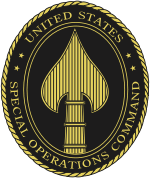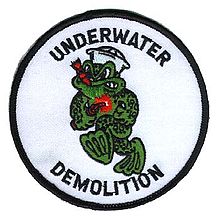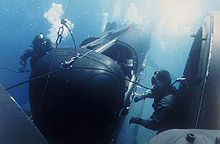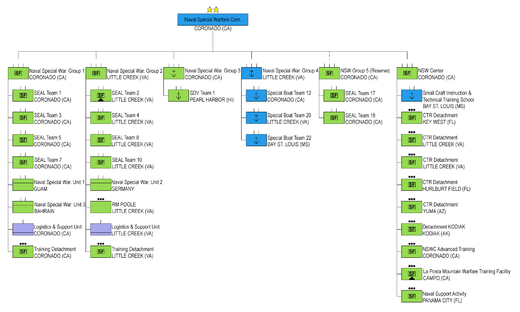- United States Naval Special Warfare Command
-
Naval Special Warfare Command 
Active April 16, 1987 – present Country  United States of America
United States of AmericaBranch  United States Navy
United States NavyRole NSW provides a versatile, responsive and offensively focused force with continuous overseas presence Size Classified Part of U.S. Special Operations Command (USSOCOM) Garrison/HQ Naval Amphibious Base Coronado Engagements Vietnam War
Armed Forces Expeditions – Grenada
Armed Forces Expeditions – Persian Gulf
War in Southwest Asia
Armed Forces Expeditions – Somalia
Battle of Mogadishu
Afghanistan CampaignIraq Campaign
Commanders Current
commanderRear Admiral Sean A. Pybus[1] The United States Naval Special Warfare Command (NAVSPECWARCOM, NAVSOC or NSWC)[2] was commissioned on April 16, 1987, at Naval Amphibious Base Coronado in San Diego, California. As the Naval component to the United States Special Operations Command, headquartered at MacDill AFB in Tampa, Florida, Naval Special Warfare Command provides vision, leadership, doctrinal guidance, resources and oversight to ensure component maritime special operations forces are ready to meet the operational requirements of combatant commanders.[3]
Contents
Background
Today's Naval Special Warfare operators can trace their origins to the Scouts and Raiders, Naval Combat Demolition Units, Office of Strategic Services Operational Swimmers, Underwater Demolition Teams, and Motor Torpedo Boat Squadrons of World War II. In the Vietnam era, the Navy drew most of its SEALs from the Underwater Demolition Teams; from the early 1960s up until 1983 the SEAL Teams and UDTs coexisted. Navy SEALs typically traced their origin to the Scouts and Raiders while the Underwater Demolition Teams traced theirs to the Navy Combat Demolition Units (the Navy drew its UDTs from NCDUs). However, in 1983 the Underwater Demolition Teams were merged with the SEAL Teams. This, in turn, merged their ancestry. While none of those early organizations have survived to present, their pioneering efforts in unconventional warfare are mirrored in the missions and professionalism of the present Naval Special Warfare warriors.
To meet the need for a beach reconnaissance force, selected Army and Navy personnel assembled at Amphibious Training Base Little Creek, Virginia, on August 15, 1942 to begin Amphibious Scouts and Raiders (Joint) training. The Scouts and Raiders mission was to identify and reconnoiter the objective beach, maintain a position on the designated beach prior to a landing and guide the assault waves to the landing beach.
World War II
By the time the United States became involved in World War II, Adolf Hitler and the Axis forces had control over a large portion of Europe, Asia and North Africa. If the Allied forces were to stand a chance, there would have to be several full-scale landings. The US Navy decided that to do the job right required sending in their own. They needed men to reconnoiter the landing beaches, take note of obstacles and defenses and ultimately guide the landing forces in. Later, during the war, the Army Engineers passed down demolition jobs to the US Navy. They were to clear any obstacles and/or defenses in the near shore area. Beginning a tradition that continues today. [4]
Scouts & Raiders
The Navy Scouts and Raiders were created before the Navy Combat Demolition Units (NCDUs). The Scouts and Raiders were first formed in September 1942, nine months after the attack on Pearl Harbor, from the Observer Group, a joint Marine Corps-Army-Navy unit. The Observer Group was the first unit trained in amphibious reconnaissance.[5] They trained in inflatable boat insertions from submarines around the Chesapeake Bay and at the Amphibious Training Base (ATB) Little Creek in Virginia and in Fort Pierce, Florida. They were training for an intense clandestine mission in North Africa.[6]
However, the Observer Group was disbanded, with the Marine Corps counterpart forming the Amphib Recon Company; the Army/Navy unit formed the Scouts and Raiders and continued its deployment to North Africa as planned,[6] where they earned eight Navy Crosses. Robert Halperin, a former NFL football player and future Olympic medalist who landed his ship in complete darkness on the shore of French Morocco, located and marked landing beaches, guided assault troops to their targets, and captured two enemy officers, received a Presidential Citation and the Navy Cross.[7] This was just the first of many war-time missions for the versatile Scouts and Raiders.[8]
First Group
The first group included Phil H. Bucklew, the "Father of Naval Special Warfare," after whom the Naval Special Warfare Center building is named. Commissioned in October 1942, this group saw combat in November 1942 during Operation Torch, the first allied landings in Europe, on the North African coast. Scouts and Raiders also supported landings in Sicily, Salerno, Anzio, Normandy, and southern France.
Second Group
A second group of Scouts and Raiders, code-named Special Service Unit #1, was established on 7 July 1943, as a joint and combined operations force. The first mission, in September 1943, was at Finschafen on New Guinea. Later operations were at Gasmata, Arawe, Cape Gloucester, and the East and South coast of New Britain, all without any loss of personnel. Conflicts arose over operational matters, and all non-Navy personnel were reassigned. The unit, renamed 7th Amphibious Scouts, received a new mission, to go ashore with the assault boats, buoy channels, erect markers for the incoming craft, handle casualties, take offshore soundings, blow up beach obstacles and maintain voice communications linking the troops ashore, incoming boats and nearby ships. The 7th Amphibious Scouts conducted operations in the Pacific for the duration of the conflict, participating in more than 40 landings.
Third Group
The third Scout and Raiders organization operated in China. Scouts and Raiders were deployed to fight with the Sino-American Cooperative Organization, or SACO. To help bolster the work of SACO, Admiral Ernest J. King ordered that 120 officers and 900 men be trained for "Amphibious Raider" at the Scout and Raider school at Fort Pierce, Florida. They formed the core of what was envisioned as a "guerrilla amphibious organization of Americans and Chinese operating from coastal waters, lakes and rivers employing small steamboats and sampans." While most Amphibious Raider forces remained at Camp Knox in Calcutta, three of the groups saw active service. They conducted a survey of the upper Yangtze River in the spring of 1945 and, disguised as coolies, conducted a detailed three-month survey of the Chinese coast from Shanghai to Kitchioh Wan, near Hong Kong
In September 1942, 17 Navy salvage personnel arrived at ATB Little Creek, Virginia for a one-week concentrated course on demolitions, explosive cable cutting and commando raiding techniques. On November 10, 1942, this first combat demolition unit succeeded in cutting a cable and net barrier across the Wadi Sebou River during Operation Torch in North Africa. Their actions enabled the USS Dallas (DD-199) to traverse the river and insert Army Rangers, who proceeded to capture the Port Lyautey aerodrome.
Plans for a massive cross-channel invasion of Europe had begun and intelligence indicated that the Germans were placing extensive underwater obstacles on the beaches at Normandy. On May 7, 1943, Lieutenant Commander Draper L. Kauffman, "The Father of Naval Combat Demolition," was directed to set up a school and train people to eliminate obstacles on an enemy-held beach prior to an invasion. On June 6, 1943, LCDR Kaufmann established Naval Combat Demolition Unit training at Fort Pierce. By April 1944, a total of 34 NCDUs were deployed to England in preparation for Operation OVERLORD, the amphibious landing at Normandy.
On June 6, 1944, in the face of great adversity, the NCDUs at Omaha Beach managed to blow eight complete gaps and two partial gaps in the German defenses. The NCDUs suffered 31 killed and 60 wounded, a casualty rate of 52%. Meanwhile, the NCDUs at Utah Beach met less intense enemy fire. They cleared 700 yards (640 m) of beach in two hours, another 900 yards (820 m) by the afternoon. Casualties at Utah Beach were significantly lighter with six killed and eleven wounded. During Operation OVERLORD, not a single demolitioneer was lost to improper handling of explosives.
In August 1944, NCDUs from Utah Beach participated in the landings in southern France, the last amphibious operation in the European Theater of Operations. NCDUs also operated in the Pacific theater. NCDU 2, under LTjg Frank Kaine, after whom the Naval Special Warfare Command building is named, and NCDU 3 under LTjg Lloyd Anderson, formed the nucleus of six NCDUs that served with the Seventh Amphibious Force tasked with clearing boat channels after the landings from Biak to Borneo.
OSS Operational Swimmers
Some of the earliest World War II predecessors of the SEALs were the Operational Swimmers of the Office of Strategic Services, or OSS.[9] Many current SEAL missions were first assigned to them. OSS specialized in special operations, dropping operatives behind enemy lines to engage in organized guerrilla warfare as well as to gather information on such things as enemy resources and troop movements. [10]
British Combined Operations veteran LCDR Wooley, of the Royal Navy, was placed in charge of the OSS Maritime Unit in June 1943. Their training started in November 1943 at Camp Pendleton, California, moved to Santa Catalina Island, California in January 1944, and finally moved to the warmer waters of The Bahamas in March 1944. Within the U.S. military, they pioneered flexible swimfins and diving masks, closed-circuit diving equipment (under the direction of Dr. Chris Lambertsen), the use of Swimmer Delivery Vehicles (a type of submersible), and combat swimming and limpet mine attacks.[9]
In May 1944, General Donovan, the head of the OSS, divided the unit into groups. He loaned Group 1, under Lieutenant Choate, to Admiral Nimitz, as a way to introduce the OSS into the Pacific theater. They became part of UDT-10 in July 1944. Five OSS men participated in the very first UDT submarine operation with the USS Burrfish (SS-312) in the Caroline Islands in August 1944.
Underwater Demolition Teams
On November 23, 1943, the U.S. Marine landing on Tarawa Atoll emphasized the need for hydrographic reconnaissance and underwater demolition of obstacles prior to any amphibious landing. After Tarawa, 30 officers and 150 enlisted men were moved to the Waimānalo Amphibious Training Base to form the nucleus of a demolition training program. This group became Underwater Demolition Teams (UDT) ONE and TWO.
The UDTs saw their first combat on January 31, 1944, during Operation Flintlock in the Marshall Islands. FLINTLOCK became the real catalyst for the UDT training program in the Pacific Theater. In February 1944, the Naval Combat Demolition Training and Experimental Base was established at Kīhei, Maui, next to the Amphibious Base at Kamaole. Eventually, 34 UDT teams were established. Wearing swim suits, fins, and dive masks on combat operations, these "Naked Warriors" saw action across the Pacific in every major amphibious landing including: Eniwetok, Saipan, Guam, Tinian, Angaur, Ulithi, Peleliu, Leyte, Lingayen Gulf, Zambales, Iwo Jima, Okinawa, Labuan, Brunei Bay, and on July 4, 1945 at Balikpapan on Borneo, which was the last UDT demolition operation of the war.
The rapid demobilization at the conclusion of the war reduced the number of active duty UDTs to two on each coast with a complement of seven officers and 45 enlisted men each.
The Korean War began on June 25, 1950, when the North Korean army invaded South Korea. Beginning with a detachment of 11 personnel from UDT 3, UDT participation expanded to three teams with a combined strength of 300 men. As part of the Special Operations Group, or SOG, UDTs successfully conducted demolition raids on railroad tunnels and bridges along the Korean coast. On September 15, 1950, UDTs supported Operation Chromite, the amphibious landing at Incheon. UDT 1 and 3 provided personnel who went in ahead of the landing craft, scouting mud flats, marking low points in the channel, clearing fouled propellers, and searching for mines. Four UDT personnel acted as wave-guides for the Marine landing.
In October 1950, UDTs supported mine-clearing operations in Wonsan Harbor where frogmen would locate and mark mines for minesweepers. On October 12, 1950, two U.S. minesweepers hit mines and sank. UDTs rescued 25 sailors. The next day, William Giannotti conducted the first U.S. combat operation using an "aqualung" when he dove on the USS Pledge (AM-277). For the remainder of the war, UDTs conducted beach and river reconnaissance, infiltrated guerrillas behind the lines from sea, continued mine sweeping operations, and participated in Operation Fishnet, which severely damaged the North Korean's fishing capability.
Although Naval Special Warfare personnel comprise less than one percent of U.S. Navy personnel, they offer big dividends on a small investment. SEAL and SWCC units' proven ability to operate across the spectrum of conflict and in operations other than war in a controlled manner, and their ability to provide real time intelligence and eyes on target, offer decision makers immediate and virtually unlimited options in the face of rapidly changing crises around the world. [11]
SEALs
SEALs are Special Operations Command’s force-of-choice to conduct small-unit maritime military operations which originate from, and return to a river, ocean, swamp, delta or coastline. This littoral capability is considered more important now than ever, as half the world’s infrastructure and population is located within one mile (1.6 km) of an ocean or river. [12]
Responding to President John F. Kennedy's desire for the Services to develop an Unconventional Warfare (UW) capability, the US Navy established SEAL Team ONE and SEAL Team TWO in January 1962. Formed entirely with personnel from Underwater Demolition Teams, the SEALs' mission was to conduct counter guerrilla warfare and clandestine operations in maritime and riverine environments. [13]
Navy SEALs have distinguished themselves as an individually reliable, collectively disciplined and highly skilled maritime force. Because of the dangers inherent in NSW, prospective SEALs go through what is considered by many military experts to be the toughest training in the world. The intense physical and mental conditioning it takes to become a SEAL begins at Basic Underwater Demolition/SEAL (BUD/S) training.
SEAL candidates begin BUD/S training at the Naval Special Warfare Center, NAB Coronado, California. This six-month course of instruction focuses on physical conditioning, small boat handling, diving physics, basic diving techniques, land warfare, weapons, demolitions, communications, and reconnaissance.
First Phase trains, develops, and assesses SEAL candidates in physical conditioning, water competency, teamwork, and mental tenacity. Second (Diving) Phase trains, develops, and qualifies SEAL candidates as competent basic combat swimmers. During this period, physical training continues and becomes even more intensive. Emphasis is placed on long distance underwater dives with the goal of training students to become basic combat divers, using swimming and diving techniques as a means of transportation from their launch point to their combat objective. This is a skill that separates SEALs from all other Special Operations forces. Third Phase trains, develops, and qualifies SEAL candidates in basic weapons, demolition, and small unit tactics. Third Phase concentrates on teaching land navigation, small-unit tactics, patrolling techniques, abseiling, marksmanship, and military explosives. The final three and a half weeks of Third Phase are spent at NALF San Clemente Island,[14] where students apply all the techniques they have acquired during training. [15]
SDVTs
SEAL Delivery Vehicle Teams' historical roots began during WWII with the earliest human torpedos to see use: Maiale, used by Italy's Decima Flottiglia MAS, and Chariots, used by British commando frogmen. Naval Special Warfare entered the wet submersible field in the 1960s when the Coastal Systems Center in Panama City, FL developed the Mark 7, a free-flooding SDV of the type used today, and the first SDV to be used in the fleet. The Mark 8 and 9 followed in the late 1970s.
Today's Mark 8 Mod 1 provides NSW with an unprecedented capability that combines the attributes of clandestine underwater mobility and the combat swimmer. The Advanced SEAL Delivery System (ASDS) program that would have provided NSW a new (dry) submersible for long range infiltration missions was abandoned in 2009.
SWCC

The exclusive mission of Special Warfare Combatant-craft Crewmen operators is to expertly drive and provide small-caliber gunfire support on specialized high-tech, high-speed, and low-profile Surface Combatant Craft to secretly infiltrate and exfiltrate Navy SEALs on Special Operations missions worldwide. These missions include direct action on land, sea, coastline or rivers (such as strikes, captures, and ship take downs by Visit, Board, Search, and Seizure), special reconnaissance, Coastal Patrol and Interdiction of suspect ships and surface craft, counter-terrorism operations, riverine warfare, deception operations, search and rescue operations, and foreign internal defense missions. [16] Although SEALs and SWCC undergo different training programs, both are focused on special operations in maritime environments. The SWCC program includes extensive training on craft and weapons tactics, techniques, and procedures. Like SEALs, SWCC must show physical fitness, possess strong motivation, be combat focused, and maintain responsiveness in high stress situations. [17]
The SWCC designation is a relatively new Naval Special Warfare career path that is independent of the regular line Navy. Today’s Special Boat Teams have their origins in the PT boats of WWII and the “Brown Water” naval force that was created in 1965 at the onset of the Vietnam War. Patrol Coastal and Patrol Torpedo ships are the ancestors of today's Cyclone class patrol ships and Mark V Special Operations Craft.
Structure
Global War on Terror
NSW is committed to combating the global terrorist threats. In addition to being experts in special reconnaissance and direct action missions, the skill sets needed to combat terrorism; NSW is postured to fight a dispersed enemy on their territory. NSW forces can operate from forward-deployed Navy ships, submarines and aviation mobility platforms as well as overseas bases and its own overseas units.
War in Afghanistan
In response to the attacks on America 11 Sept. 2001, Naval Special Warfare forces put operators on the ground in Afghanistan in October. The first military flag officer to set foot in Afghanistan was a Navy SEAL, Rear Admiral Albert Calland, in charge of United States Special Operations Command Central, which was responsible for all special operations for Central Command.[18] Additionally, a Navy SEAL captain commanded Combined Joint Special Operations Task Force (CJSOTF) South. Commonly referred to as Task Force K-Bar, the task force included Navy, Army, Air Force and Coalition Special Operations forces. During Operation Enduring Freedom, NSW forces carried out more than 75 special reconnaissance and direct action missions, destroying more than 500,000 pounds of explosives and weapons; positively identifying enemy personnel and conducting Leadership Interdiction Operations in the search for terrorists trying to escape by sea-going vessels.
Operation Red Wing, a counter insurgent mission in Kunar Province, Afghanistan, involved four Navy SEALs and took place on June 28, 2005. The SEALs were on a mission to try to find a key Taliban leader. However, goat herders stumbled upon their hiding place and alerted local Taliban fighters, and they were subsequently surrounded by Taliban forces. The four SEALs requested back up after the Taliban had surrounded them. In the attempt to rescue the four SEALs on the ground a chinook helicopter containing members of SEAL delivery team one and several Army “Nightstalker” commandos was shot down. This is the biggest single loss of life for Naval Special Warfare forces since World War II<citation needed>. A firefight ensued, killing three SEALs. The fourth, Marcus Luttrell, was protected by local villagers and later rescued by the US military. The team leader, SEAL Lieutenant Michael P. Murphy, was posthumously awarded the Medal of Honor.
SEAL Senior Chief Petty Officer Dan Healy was awarded the Bronze Star with Combat “V” for Valor, Purple Heart, and Afghanistan Campaign Medal, posthumously.
Iraq War
Naval Special Warfare has played a significant role in Operation Iraqi Freedom, employing the largest number of SEALs and SWCC in its history. NSW forces were instrumental in numerous special reconnaissance and direct action missions including the securing of the southern oil infrastructures of the Al Faw peninsula and the off-shore gas and oil terminals; the clearing of the Khawr Abd Allah and Khawr Az Zubayr waterways that enabled humanitarian aid to be delivered to the vital port city of Umm Qasr; reconnaissance of the Shatt al-Arab waterway; capture of high value targets, raids on suspected chemical, biological and radiological sites; and the first POW rescue since WWII. Additionally, NSW is also fighting the war on terrorism in other global hot spots including the Philippines and the Horn of Africa. [19]
SEAL Petty Officer Second Class Michael A. Monsoor was posthumously awarded the Medal of Honor for actions in Ramadi, Iraq.
See also
- United States Navy SEALs
- List of Navy SEALs
- United States Navy SWCC
- United States Naval Special Warfare Development Group
- Naval Special Warfare Group THREE
- Naval Special Warfare Center
- Underwater Demolition Team
References
Much of this text in this article was taken from Official U.S. Navy SWCC web site which as a work of the U.S. Government is presumed to be a public domain resource.
- Notes
- ^ [1]
- ^ navsoc.navy.mil
- ^ Naval Special Warfare – Official U.S. Navy Web Site
- ^ "UDT-SEAL Museum:History". http://navysealmuseum.com/heritage/historyWW2.php. Retrieved January 24, 2008.
- ^ Shinn, lstLt Leo B. (April 1945). "Amphibious Reconnaissance". Marine Corps Gazette 29 (4).
- ^ a b Bruce F. Meyers, Swift, Silent, and Deadly: Marine Amphibious Reconnaissance in the Pacific, 1942–1945, (Annapolis, MD: Naval Institute Press, 2004).
- ^ Kenan Heise (May 9, 1985). "Robert Halperin, 77, War Hero, Executive". Chicago Tribune. http://articles.chicagotribune.com/1985-05-09/news/8501290068_1_mr-halperin-palm-springs-landing. Retrieved July 11, 2011.
- ^ "Scouts & Raiders history". http://www.navyfrogmen.com/Scouts%20and%20Raiders.html. Retrieved January 2, 2008.
- ^ a b Butler FK (2004). "Closed-circuit oxygen diving in the U.S. Navy". Undersea Hyperb Med 31 (1): 3–20. PMID 15233156. http://archive.rubicon-foundation.org/3986. Retrieved March 19, 2009.
- ^ "OSS History". http://www.militaryhistoryonline.com/general/articles/officestrategicservices.aspx. Retrieved January 2, 2008.
- ^ "NAVSOC mission". https://www.navsoc.navy.mil/missions.htm. Retrieved January 21, 2008.
- ^ "Navy SEAL History". http://www.navyseals.com/navy-seal-history. Retrieved January 21, 2008.
- ^ "Official U.S. Navy SEAL Information Website, Into". http://www.sealchallenge.navy.mil/seal/introduction.aspx. Retrieved January 21, 2008.
- ^ "Naval Auxiliary Landing Field, San Clemente Island". Naval Base Coronado. United States Navy. https://www.cnic.navy.mil/Coronado/Installations/SanClementeIsland/index.htm. Retrieved November 18, 2008.
- ^ "BUD/S (Basic Underwater Demolition / SEAL) – Naval Special Warfare Center". Official U.S. Navy SEAL Information Website. United States Navy. http://www.seal.navy.mil/seal/buds.aspx. Retrieved January 21, 2008.
- ^ "Navy SWCC – The Navy's Elite Boat Warriors". NavySEALs.com. http://www.navyseals.com/navy-swcc-navys-elite-boat-warriors. Retrieved January 2, 2008.
- ^ "Introduction to SWCC and Naval Special Warfare". Official U.S. Navy SWCC Information. United States Navy. http://www.seal.navy.mil/swcc/introduction.aspx. Retrieved January 2, 2008.
- ^ http://www.forum.militaryltd.com/sea-air-land-seal-teams/m447-nswarrior
- ^ "NAVSOC History". https://www.navsoc.navy.mil/history.htm. Retrieved January 2, 2008.
- Bibliography
- [2] Naval Special Warfare website
- [3] Naval Special Warfare, History page
- [4] Official U.S. Navy Seal Information Website
- [5] Official U.S. Navy SWCC Information Website
- Luttrell, Marcus. (2007). Lone Survivor: The Eyewitness Account of Operation Redwing and the Lost Heroes of SEAL Team 10, New York: Hachette Book Group USA. (ISBN 0-316-06759-8)
- Cunningham, Chet. (2005). The Frogmen of World War II: An Oral History of the U.S. Navy's Underwater Demolition Teams, New York: Pocket Books. (ISBN 0-7434-8216-6)
External links
- U.S. Naval Special Warfare Command – official site.
- NavySeals.com
- ShadowSpear.com Special Operations
United States Army
USASOCSpecial Forces · U.S. Army John F. Kennedy Special Warfare Center and School · 75th Ranger Regiment · 160th Special Operations Aviation Regiment
United States Marine Corps
MARSOCUnited States Navy
NAVSPECWARCOMUnited States Air Force
AFSOCUnits: 1st Special Operations Wing · 27th Special Operations Wing · 352nd Special Operations Group · 353rd Special Operations Group
Types: Air Force Pararescue · Combat Control Team · Special Operations Weather · SERE · Tactical Air Control PartySpecial Mission Units
JSOCArmy: 1st SFOD - Delta (Delta Force) · Intelligence Support Activity
Navy: Naval Special Warfare Development Group (DEVGRU / SEAL Team Six)
Air Force: 24th Special Tactics Squadron
Other: Advanced Force Operations (AFO)Source: SOCOM Fact BookCategories:- Special Operations Forces of the United States
- United States Naval Special Warfare Command
- United States Navy organization
- United States Special Operations Command
Wikimedia Foundation. 2010.






